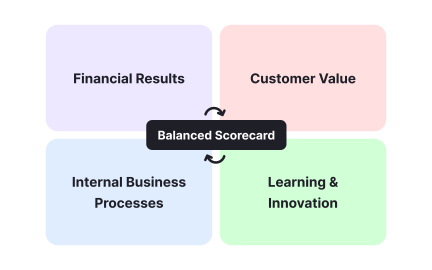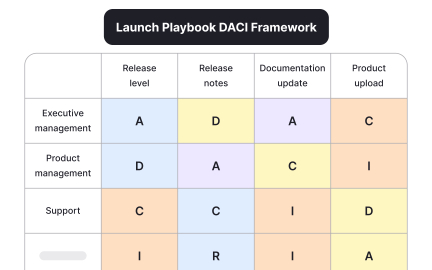Product Development Process
The product development process outlines the full journey from idea to launch, helping teams build, test, and deliver value in stages.
What is Product Development Process?
Your product development feels chaotic and unpredictable because teams work without systematic approaches to moving from ideas to launched products, leading to missed deadlines, scope confusion, and quality issues that damage customer satisfaction and competitive positioning.
Most companies develop products through ad-hoc activities and heroic individual efforts without repeatable processes, missing opportunities to build predictable delivery capabilities that consistently transform ideas into successful products while managing risk and resources effectively.
A product development process is the systematic framework of stages, activities, and decision points that guide products from initial concept through market launch and beyond, creating repeatable paths to transform ideas into valuable solutions while managing quality, time, and resources.
Companies with mature product development processes achieve 45% faster time-to-market, 60% fewer product failures, and significantly better resource utilization because development follows proven patterns rather than reinventing approaches for each new product.
Think about how Apple's product development process creates consistent innovation from Mac to iPhone to AirPods, or how Amazon's working backwards process ensures every product serves clear customer needs before development begins.
Why Product Development Process Matters for Innovation Success
Your innovation efforts produce inconsistent results because each product follows different approaches without systematic learning from successes and failures, leading to repeated mistakes and missed opportunities to build competitive advantages through development excellence.
The cost of lacking systematic development processes compounds through every delayed launch and failed product. You waste resources on unclear requirements, create quality issues through rushed development, miss market windows, and lose competitive advantage when competitors deliver better products faster.
What effective product development processes deliver:
Better innovation success rates and reduced product failures because systematic processes incorporate learning from past products rather than repeating mistakes without organizational memory and improvement.
When development follows proven processes, teams avoid common pitfalls rather than discovering problems late when fixes are expensive or impossible without major rework.
Enhanced cross-functional coordination and collaboration through clear stages and handoffs that ensure all disciplines contribute effectively rather than siloed development without integration.
Improved resource planning and utilization because systematic processes enable accurate estimation and resource allocation rather than crisis-driven development that wastes capacity.
Stronger quality and customer satisfaction through built-in validation stages that catch issues early rather than discovering problems after launch when reputation damage occurs.
More predictable delivery and business planning as systematic processes create reliable timelines rather than hopeful estimates without historical validation or risk management.
Advanced Product Development Processes
Once you've established basic development processes, implement sophisticated optimization and innovation approaches.
Agile-Waterfall Hybrid Processes: Combine agile flexibility with stage-gate structure rather than pure methodologies, optimizing for both innovation and predictability.
Platform-Based Development Processes: Design processes for product families rather than individual products, enabling efficiency through shared components and learning.
Customer-Integrated Development Processes: Build customer validation throughout rather than just at launch, ensuring market fit through continuous feedback.
Metrics-Driven Process Optimization: Use data to continuously improve processes rather than static frameworks, ensuring development excellence evolves with market needs.
Step 1: Map Current Development Reality and Identify Gaps (Week 1)
Document how products actually get developed today including pain points and inefficiencies rather than designing ideal processes without understanding current state and improvement opportunities.
This creates process foundation based on organizational reality rather than theoretical frameworks that don't account for culture, capabilities, and constraints.
Step 2: Define Clear Development Stages and Gates (Week 1-2)
Establish distinct phases from ideation through launch with specific criteria for progression rather than blurred stages without clear transitions and decision points.
Focus stage definition on value creation rather than bureaucratic checkpoints, ensuring each phase adds meaningful progress toward product success.
Step 3: Create Stage-Specific Activities and Deliverables (Week 2-3)
Define what happens in each stage including required outputs and decision criteria rather than vague phase descriptions without actionable guidance.
Balance process completeness with flexibility to ensure guidance without constraining innovation or creating bureaucratic overhead that slows development.
Step 4: Implement Tools and Templates for Consistency (Week 3-4)
Develop reusable assets that embed best practices rather than forcing teams to recreate approaches, accelerating development while ensuring quality.
Step 5: Establish Continuous Process Improvement (Week 4+)
Monitor process effectiveness and evolve based on results rather than rigid adherence to initial design, ensuring processes improve rather than becoming outdated constraints.
This ensures product development processes enhance innovation rather than bureaucratic compliance that stifles creativity without improving outcomes.
If development processes don't improve results, examine whether they serve product success rather than process compliance without business value creation.
The Problem: Development processes that become bureaucratic barriers rather than innovation enablers, slowing development without proportionally improving success rates.
The Fix: Focus processes on value creation rather than compliance, regularly pruning activities that don't directly contribute to product success or risk reduction.
The Problem: One-size-fits-all processes that don't accommodate different product types, innovation levels, or market contexts within the organization.
The Fix: Create process variants for different scenarios rather than forcing all products through identical stages, maintaining consistency while enabling appropriate flexibility.
The Problem: Process adoption resistance from teams who see frameworks as constraining creativity rather than enabling systematic innovation.
The Fix: Involve teams in process design and emphasize how structure enables rather than constrains innovation, showing how processes accelerate rather than slow development.
Create product development processes that enhance innovation speed and success rather than adding bureaucracy without improving outcomes.
Recommended resources
Courses

Product Discovery

Product Analytics










